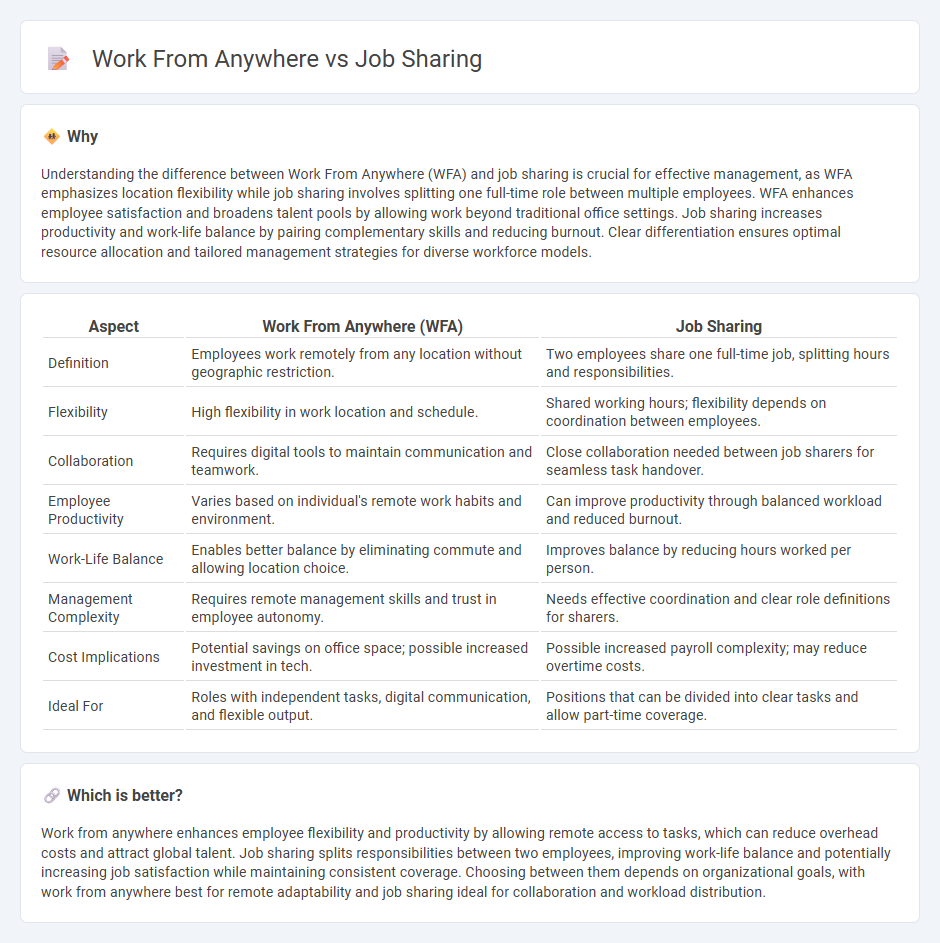
Work from anywhere enables employees to perform tasks remotely from any location, increasing flexibility and access to a broader talent pool. Job sharing splits one full-time position between two or more employees, promoting work-life balance and enhancing productivity through collaboration. Discover how these management strategies can optimize workforce dynamics and boost organizational efficiency.
Why it is important
Understanding the difference between Work From Anywhere (WFA) and job sharing is crucial for effective management, as WFA emphasizes location flexibility while job sharing involves splitting one full-time role between multiple employees. WFA enhances employee satisfaction and broadens talent pools by allowing work beyond traditional office settings. Job sharing increases productivity and work-life balance by pairing complementary skills and reducing burnout. Clear differentiation ensures optimal resource allocation and tailored management strategies for diverse workforce models.
Comparison Table
| Aspect | Work From Anywhere (WFA) | Job Sharing |
|---|---|---|
| Definition | Employees work remotely from any location without geographic restriction. | Two employees share one full-time job, splitting hours and responsibilities. |
| Flexibility | High flexibility in work location and schedule. | Shared working hours; flexibility depends on coordination between employees. |
| Collaboration | Requires digital tools to maintain communication and teamwork. | Close collaboration needed between job sharers for seamless task handover. |
| Employee Productivity | Varies based on individual's remote work habits and environment. | Can improve productivity through balanced workload and reduced burnout. |
| Work-Life Balance | Enables better balance by eliminating commute and allowing location choice. | Improves balance by reducing hours worked per person. |
| Management Complexity | Requires remote management skills and trust in employee autonomy. | Needs effective coordination and clear role definitions for sharers. |
| Cost Implications | Potential savings on office space; possible increased investment in tech. | Possible increased payroll complexity; may reduce overtime costs. |
| Ideal For | Roles with independent tasks, digital communication, and flexible output. | Positions that can be divided into clear tasks and allow part-time coverage. |
Which is better?
Work from anywhere enhances employee flexibility and productivity by allowing remote access to tasks, which can reduce overhead costs and attract global talent. Job sharing splits responsibilities between two employees, improving work-life balance and potentially increasing job satisfaction while maintaining consistent coverage. Choosing between them depends on organizational goals, with work from anywhere best for remote adaptability and job sharing ideal for collaboration and workload distribution.
Connection
Work from anywhere policies enhance job sharing by enabling employees to collaborate seamlessly across diverse locations, increasing flexibility and productivity. Job sharing divides roles between two part-time workers, and remote work technologies support continuous communication and task management regardless of physical presence. This synergy promotes work-life balance and optimizes talent utilization within modern management practices.
Key Terms
Flexibility
Job sharing offers flexibility by allowing two employees to split one full-time position, adapting schedules to accommodate personal needs while maintaining role continuity. Work from anywhere provides greater location independence, enabling employees to perform tasks from any geographic location, fostering a highly adaptable work environment. Explore the advantages of both approaches to determine which flexibility model best suits your organizational needs.
Collaboration
Job sharing fosters collaboration by dividing responsibilities between two employees who must communicate closely to ensure seamless task completion and maintain consistent productivity. Work from anywhere promotes collaboration through digital tools, enabling teams to connect across geographic barriers but requiring intentional effort to sustain engagement and teamwork. Discover how these work models influence collaboration dynamics and which aligns best with your organizational goals.
Autonomy
Job sharing offers increased autonomy by allowing employees to split responsibilities and tailor schedules for better work-life balance, fostering a sense of control over tasks and time management. Work from anywhere enhances autonomy by granting employees the freedom to choose their work environment, boosting productivity and satisfaction through flexible location options. Discover more about how autonomy influences productivity and employee well-being in these flexible work models.
Source and External Links
The Benefits of Job Sharing for Employers and Employees - Job sharing is an innovative employment arrangement where two or more employees share the responsibilities and duties of a single full-time job, benefiting both employers and employees.
What is job sharing? - Job sharing is a form of flexible working that enables two employees to share the responsibilities and duties of a single full-time job, promoting work-life balance.
Job Sharing And The Benefits For Employers - Job sharing offers employers access to a wider talent pool by accommodating diverse workforce needs, and it can unlock several organizational benefits.
 dowidth.com
dowidth.com